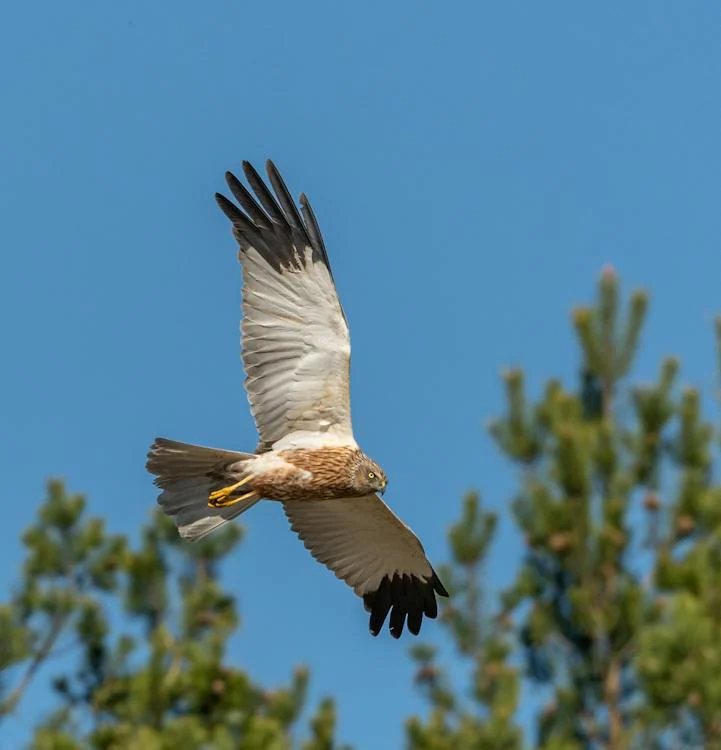It is a bird of prey whose males appear whitish gray, while females are harder to distinguish from their other harrier cousins. Barred primaries and darkish secondaries are conspicuous. When in flight, they look bulkier than Montagu’s Harrier but lighter than the Hen Harrier. It is a long-distance migrant, breeding mainly in Eastern Europe and Central Asia but winters in Africa, India, and Southeast Asia.
Read further to know more about the Pallid Harrier.
What is a Pallid Harrier?
Pallid Harrier (Circus macrourus) or Pale Harrier is a medium-sized bird of prey belonging to the Harrier family, consisting of several diurnal hawks species. The scientific name “circus” came from the Ancient Green word “kirkos,” referring to a bird species performing circling flight and “macrourus” that implies being long-tailed.
Its seven levels of classification are as follows:
Kingdom: Animalia
Phylum: Chordata
Class: Aves
Order: Accipitriformes
Family: Accipitridae
Genus: Circus
Species: C. macrourus
Pallid Harrier Physical Description
Pallid Harrier is a medium-sized harrier, growing from 16 to 19 inches or 40 to 48 centimeters, weighing around 315 grams to 445 grams, with a wingspan of 37-47 inches or 95 to 120 centimeters. Females are relatively larger and heavier than males.
Male pallid harriers are distinguished through their whitish-gray upperparts and white underparts. Narrow black tips accentuate its wings. They can be separated from the hen harriers through their narrower wings, duller plumage, distinct wing patterns, and smaller size. Meanwhile, the female pallid harriers have brown plumage, with whitish upper tail tetrices, earning them the name “ringtails.” Underparts are yellowish-brown with brown bars. While the female resembles the Montagu’s Harrier, it can be distinguished by its bolder and invariable secondary feathers.
Where can they be spotted?
Pallid Harriers breeds mainly in eastern Europe and central Asia. It is a long-distance migrant bird of prey that migrates to Africa, India, and Myanmar during the winter. It thrives in dry steppes and grassy plains nearby rivers, marshlands, and lakes. In its winter range, it occurs on wheat fields, rice paddies, mountain plateaus, open woodlands, grasslands, and marshes.
Interesting Facts You Should Know About the Pallid Harrier
Pallid Harriers feed primarily on small mammals, birds, lizards, and insects. These food items include gerbils, mice, voles, pipits, larks, locusts, and grasshoppers. They are diurnal birds of prey, spending much of their foraging and hunting up to 20 kilometers from their roosting ground. These birds catch prey by flying low above the ground, then gliding down to snatch the victim. Occasionally, they catch insects on the wing.
From August to September, pallid harriers move from their breeding ground and start their long-distance migration to their warmer or tropical wintering range. Populations from Asia migrate to eastern Africa and southern Asia, while European groups move to Africa alone. They will remain in their wintering ground until March to April before returning to their distant breeding grounds.
Pallid Harriers nest singly or in a loosely-structured group of three to five pairs. The nest is built on the ground made of a pile of grass, placed in scrubs, meadows, or swamps, covered by vegetation. The female will lay a clutch consisting of 4 to 5 eggs, which she will incubate for about a month while the male provides the food. Only two to three broods usually survive, fledging 35 to 40 days after hatching.
The pallid harriers’ population size is drastically declining mainly due to grasslands degradation and conversion, limiting the foraging, roosting, and breeding habitats of the bird species. They are currently classified as Near Threatened (NT) under the IUCN Red List.
WILDLIFE PARKS AND RESERVES WHERE THIS SPECIES IS FOUND:
BOTSWANA
SOUTH AFRICA
Kalahari Gemsbok National Park
NAMIBIA
ZAMBIA
ZIMBABWE
BOTSWANA BIRDS | SOUTH AFRICA BIRDS
NAMIBIA BIRDS | ZAMBIA BIRDS | ZIMBABWE BIRDS

